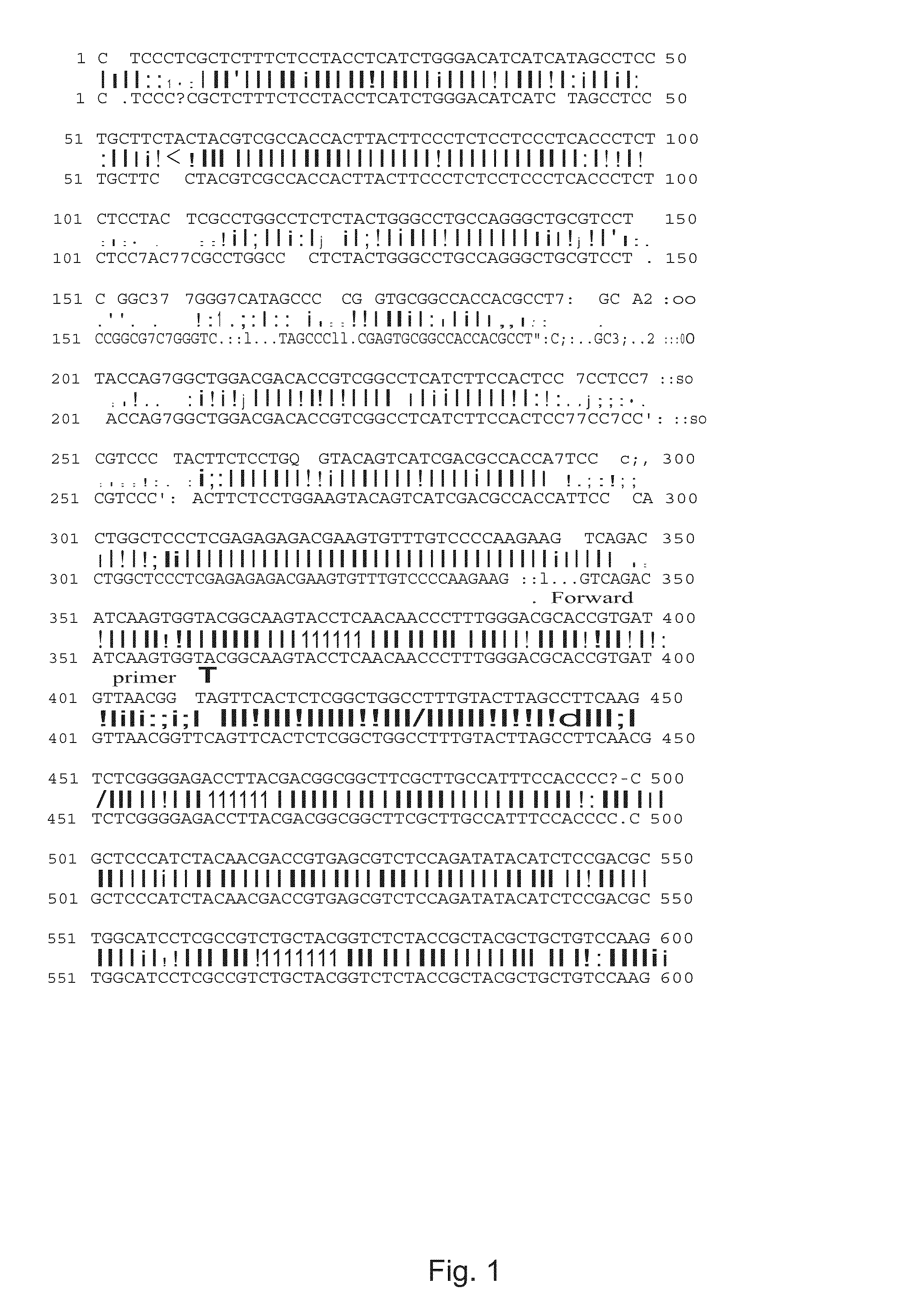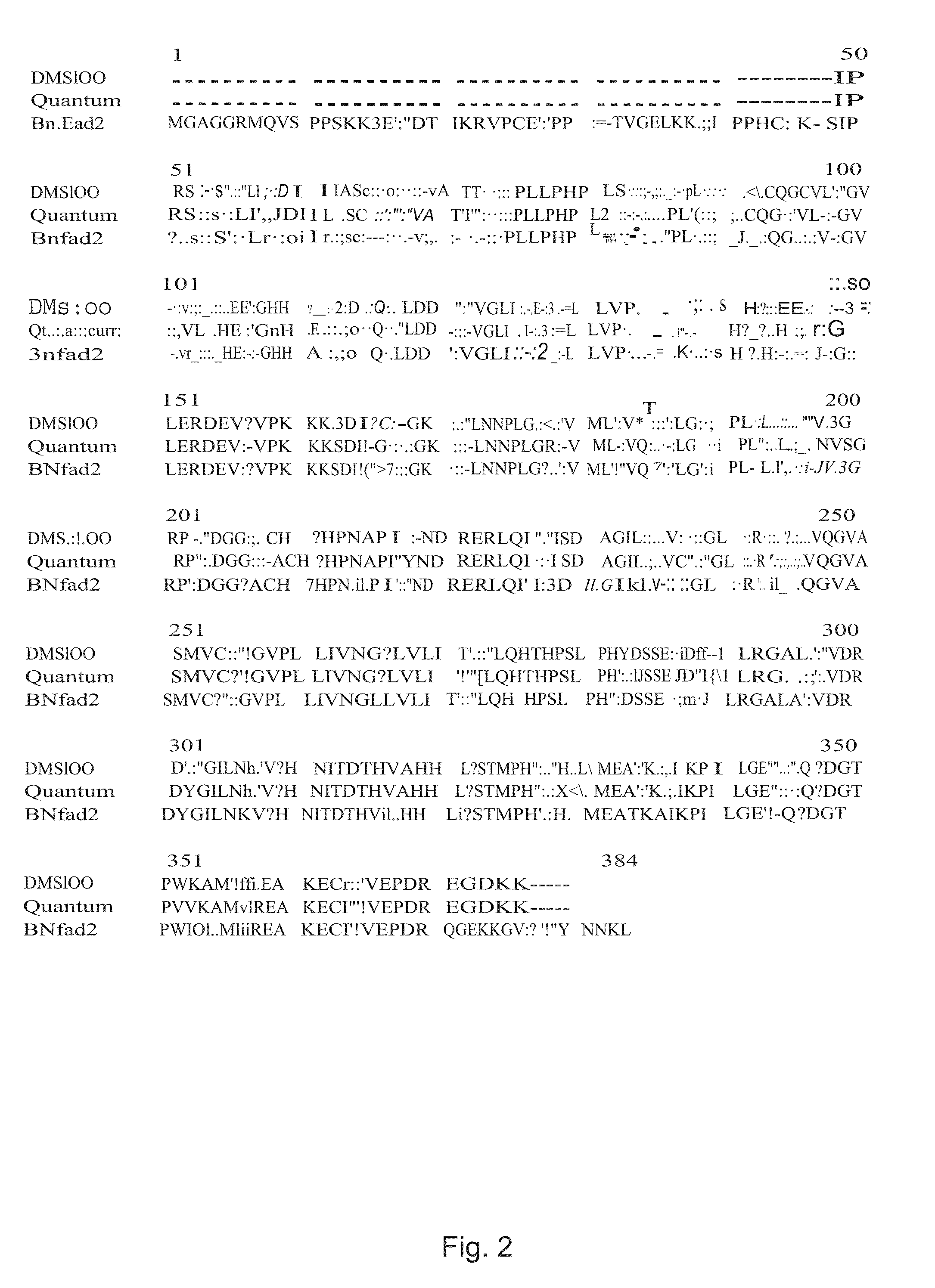Altered FAD2 and FAD3 genes in Brassica and the molecular marker-assisted detection thereof
a technology of i>brassica and /i>genes, applied in the field of plant breeding methods and materials, can solve the problems of increasing the risk of coronary heart disease, affecting the lubricating and viscosity properties, undesirable levels of polyunsaturated linolenic acid typical of conventional canola, etc., and achieves high oleic and/or low linolenic oil seed plants, reliably and predictably intro
- Summary
- Abstract
- Description
- Claims
- Application Information
AI Technical Summary
Benefits of technology
Problems solved by technology
Method used
Image
Examples
example 1
Plant Material
[0057]Canola varieties DMS100 (mutant type) and Quantum (wild type) were used in this study for cloning of fad2 (fatty acid desaturase-2) and fad3 (fatty acid desaturase-3) alleles. DMS100 is a HOLL (High Oleic and Low Linolenic) line with oleic acid content at about 77% and linolenic acid content at about 3%. It is derived from an F4 bulk of a single F3 plant selection originating from the cross of Global×AG019 sister line. Quantum is a commercial variety and contains low oleic acid (˜66%) and high linolenic acid (˜7%) content. A double haploid (DH) population was developed by microspore culture from F1 plants of the cross between canola line Quantum and DMS100. The DH population comprised of 604 lines. A complete fatty acid analysis of the seeds of the DH lines and their parents was implemented by using gas chromatography. Of the 604 DH lines, 183 were randomly selected for marker analysis and mapping.
example 2
Genomic DNA Extraction and Quantification
[0058]DNA of both parental lines and 183 DH lines was extracted from the leaves of two-week-old greenhouse-grown plants using Qiagen DNeasy 96 Plant Test Kit. The details of DNA extraction procedures are described in the DNeasy™ 96 Plant Test Kit Handbook. This kit allowed DNA to be extracted in a 96-well format for a high throughput extraction.
[0059]For DNA quantification, PicoGreen dye was diluted 200-fold into 1×TE buffer. In a microtiter plate, 100 μl of the diluted PicoGreen dye solution were added into each well and then 5 μl of each DNA sample or DNA standards (5 μg / ml, 10 μg / ml and 20 μg / ml) were added. The plate was then agitated on a plate shaker briefly and read using the Spectra Max GEMINIS XS microplate fluorometer from Molecular Devices.
example 3
PCR Amplification
[0060]PCR amplification reactions contained 20 to 30 ng of genomic DNA, 0.25 μM 10-mer primer, 2.5 mM MgCl2, 0.2 mM of each dNTP, 1×PCR buffer and 0.6 units of Tag DNA polymerase. Amplifications were performed in a GeneAmp PCR System 9700 programmed for 35 cycles of 45 seconds at 94° C., 30 seconds at 55° C. to 60° C., 1 minute at 72° C. and ending with 7 minutes at 72° C.
PUM
| Property | Measurement | Unit |
|---|---|---|
| concentration | aaaaa | aaaaa |
| nucleic acid | aaaaa | aaaaa |
| viscous properties | aaaaa | aaaaa |
Abstract
Description
Claims
Application Information
 Login to View More
Login to View More - R&D
- Intellectual Property
- Life Sciences
- Materials
- Tech Scout
- Unparalleled Data Quality
- Higher Quality Content
- 60% Fewer Hallucinations
Browse by: Latest US Patents, China's latest patents, Technical Efficacy Thesaurus, Application Domain, Technology Topic, Popular Technical Reports.
© 2025 PatSnap. All rights reserved.Legal|Privacy policy|Modern Slavery Act Transparency Statement|Sitemap|About US| Contact US: help@patsnap.com



